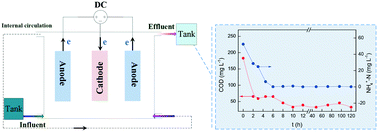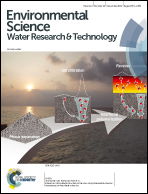Organic and nitrogen load removal from bio-treated landfill leachates by a dual-anode system
Abstract
This paper describes and discusses the feasibility and practicability of anodic oxidation integrated with an electrocoagulation process by a dual-anode system for the disposal of biologically pretreated landfill leachate. The effect of anode materials, applied voltage, and current applied on an iron anode on organic matter and ammonia removal was investigated in batch operating mode. Continuous operation systems with or without inner circulation were applied to evaluate the long-term removal performance and energy cost of this system. The results revealed that 75% of organic matter and 80% of ammonia were removed from the leachate after 2 h of treatment in the dual-anode system when a current of 1.6 A was applied on the iron anode. The composition of iron precipitates transformed from amorphous to crystalline ferric oxide particles when the current applied on the iron anode was increased. For a 5 day test, removal of 78% of COD and 99.7% of ammonia was achieved in continuous operation mode with an energy consumption of 25.6 kW h m−3, which implied the feasibility and sustainability of this technology to meet the disposal requirements of landfill leachate.


 Please wait while we load your content...
Please wait while we load your content...